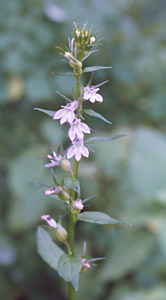

Indian Tobacco, Bluebell family (Campanulaceae), Lobelia subfamily (Lobelioideae), Native
 |
 |
The small, inconspicuous purple flowers of Indian tobacco (Lobelia inflata) usually start to appear by the middle of the summer. The base of each flower eventually develops into a swollen seed pod, making it easy to distinguish the plant from other similar-looking ones. Indian tobacco is one of a few lobelias growing at the Reservoir, including the showy red cardinal flower and the pale-spike lobelia.
Animals avoid eating the plant because of its acrid taste. In the past Indian tobacco had medicinal
uses, but it may have worked best at inducing vomiting, as other names--such as
"puke weed"--suggest. Some Native Americans chewed and smoked the leaves, practices that
reportedly brought on drowsiness.
Downy Rattlesnake-plantain, Orchid family (Orchidaceae), Native

|
The flower spikes emerge from rosettes of dark green checkerboard-patterned leaves. The plants grow in patches on the steep hillsides leading up from the Reservoir. The distinctive leaves can be spotted throughout most of the year.
Like many flowers that grow on spikes, the blossoms at the bottom of each spike develop first, with higher blossoms opening progressively as time goes on. The male parts of the flowers mature first, producing a gooey, brightly colored pollen visible at the back of the flower. Female parts become receptive later, after pollen has been collected from the blossom. This timing helps to promote cross-pollination.
Small flying insects visit each flower spike in turn, starting at the bottom and working their way up the spike before moving on to another spike and starting at the bottom again. By moving in this way, foraging pollinators pick up pollen from newly opened blossoms near the top of one plant and then deliver it to more mature, receptive flowers at the bottom of the next plant. They then repeat the process as they continue up the spike to the younger flowers and acquire more pollen.
The blossom shown here has been visited in this manner. Tiny wasps approach the blossoms using the
tongue at the front of the slipper as a landing pad, their abdomens hanging down over the front of the
slipper. From there they explore the inside of the slipper, poking their heads far into the back of
the flower and into the gooey pollen. It sticks to their heads, and when they back out, they leave a
white hole behind in the yellow and brown pollen mass at the back of the flower. The blossom then
continues to mature, later becoming receptive to pollination.
Black Nightshade, Nightshade or Potato family, Alien
 |
 |

Perhaps because both plants have black berries, black nightshade is sometimes mistaken for true "deadly nightshade," which is actually a different plant, belladonna (Atropa belladonna). Belladonna contains a poisonous chemical, atropine. It grows in central and southern Europe but is rare in North America.
In spite of its reputation for possible toxic effects, black nightshade has a history of medicinal use.
It has also served as food. The ripe berries have been added to pies in the midwest, and its boiled
leaves have been used for food by people in this country, Europe, and parts of Asia. Grazing animals,
however, avoid eating the greens. For safety's sake, children should not put the berries in their mouths.
Square-stemmed Monkey-flower, Snapdragon or Figwort family (Scrophulariaceae), Native
|

| hide TOC | 
|
| Home / Contact | ||
Copyright © Anne A. Reid, 1999-2002. Photographs copyright © Garry K. Kessler, 1999-2002. | ||